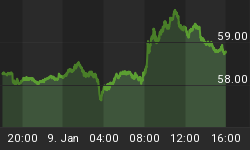
In the recent letter, Asymmetrical Warfare a chart of the 30 year yield was provided showing a potential continued 'big picture' rise in interest rates. Several weeks later, with a confirmed dovish Fed and Yale economist Robert Shiller telling politicians that "the collapse of home prices might turn out to be the most severe since the Great Depression"... "the decline in house prices stands to create future dislocations, like the credit crisis we have just seen"... and "if home price deflation persists or intensifies, they may discover that the Achilles' heel of this resilient economy is the evaporation of confidence that can accompany the end-of-boom psychology" (thanks to Kevin Depew of Minyanville), we find the long bond in continued decline (rates up) even as spooky deflation talk permeates government.
Bernanke to the rescue? I doubt it. This chart is profound in its implications. To be specific, the Fed is easing just as the short end of the bond market told them to. But on the long end, secular changes may be at hand. Throughout Greenspan's 'conundrum', long rates refused to play ball as he was hiking Fed funds. Those pesky foreign financiers of our consumer (something for nothing) economy kept rates contained by lapping up all that grade A debt. Well, it appears this game may be over.
As for the chart, I will admit that sometimes I see shapes or figures that don't really have names but when I see them I get excited. That is how I feel about the $TYX. Never mind the divergence and positive trend from 2005. The shape of this multi-year bottom simply 'looks' bullish. But back to the implications. If indeed this is rising in secular fashion, while the short end is grinding lower (1st lower panel) in fear of the ongoing credit crisis infecting the 'real' economy, and if the yield curve continues to rise (2nd lower panel) we will have continued pressure on an economy built on easy credit as the bond market (ie China, Japan, etc.) refuses to play ball this time and in fact implements the mirror opposite of Greenspan's conundrum; Dr. Dove will continue to lower rates (possibly in concert and competition with much of the industrialized world) while the bond market votes with its feet and drives up long rates.
This is potentially very nasty and patrons of the global casino are taking note. Some have slipped out the door while others, not so quick on the uptake are eying the exits nervously. And you wonder what gold is doing at fresh highs since secular changes began at the beginning of the decade?















